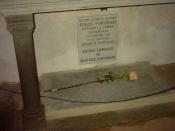Rivers 2
Many historical figures, and characters that represent others, appear throughout Dante Alighieri's Inferno, an epic that guides us through the nine Circles of Hell, as Dante himself makes his journey through. Of the numerous people mentioned during the Inferno, I would only like to discuss a few, namely those of Beatrice Portinari, the poet Virgil, and the Pope Boniface VIII. I picked these characters because of their significance, either in history or for their relation to Dante's writing and depiction of a journey through Hell in his eyes. Thus, in what follows, I will discuss each character as they are described in Inferno and each's relevance to Dante and history.
Beatrice Portinari was Dante Alighieri's childhood and lifelong love, so it's only fitting that she be seen as "the Divine Love and Grace" (Turner, 3) throughout the Inferno. Dante first encountered Beatrice at age nine.
They only actually saw each other in person twice, when they first met as children and much later when Dante was twenty-six years old, but they kept in contact via postal mail. Though they both loved each other, they married different people, yet Dante still wrote poetry to her for many more years. Beatrice then died in 1290, which is significant with Inferno being set in 1300, ten years after her death. She appears as Divine Love or Grace, which "inspires the Pilgrim [Dante] after Human Reason, represented by the poet Virgil, can go no further" (Turner). It is safe to assume the significance her death must have held for Dante in writing the Inferno, and as a strong motivator for the androgynous, Godly position she played in Dante's perception during his journey through the afterlife. Of course he would like to see his one true love guide...


